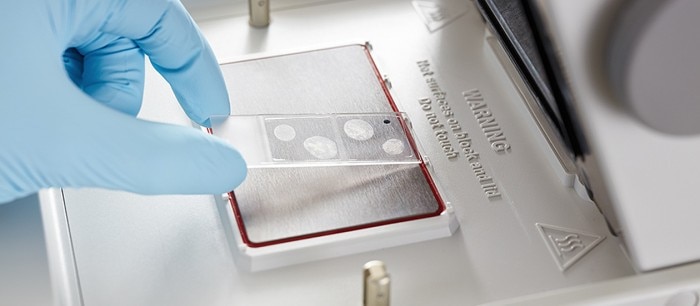MENÚ
ES | EUR
ES | EUR
-
- Centrífugas de sobremesa
- Centrífugas de suelo
- Centrífugas refrigeradas
- Microcentrífugas
- Centrífugas multiuso
- Centrífugas de alta velocidad
- Ultracentrífugas
- Concentrador
- Productos IVD
- High-Speed and Ultracentrifugation Consumables
- Tubos
- Placas
- Gestión de dispositivos
- Gestión de muestras e información
No se han encontrado resultados
Sugerencias de búsqueda

In-Situ PCR: PCR Directly Inside a Cell?
Academia de laboratorio
- Biología molecular
- Amplificación y PCR
- Cicladores para PCR
- Ensayo
In-situ means “in the original place”. In the biology context, this means in the cell, body or tissue. In-situ PCR is a technique where PCR is carried out in a section of tissue within a cell. The tissue sections of interest are attached on a microscopic slide and incubated with all necessary reagents for PCR.
DNA present inside the cells provide the template for amplification, thus this technique is useful for finding the location of a certain gene and give information on which cells in which tissue it is present (Figure 1).
Leer más
Leer menos

Figure 1: FoxP3 mRNA expression in the immune cell infiltrate of a pancreatic islet of a NOD mouse, detected after performing in situ RT-PCR on the Mastercycler nexus flat. A high number of immune cells expressed the FoxP3 gene (arrows) as a sign of regulatory potential
The primers used in in-situ PCR are coupled with “marker” molecules. (e.g. biotin or digoxigenin molecule). After PCR, the amplicons can be identified using antibodies against these markers. The antibodies can be made visible by attaching a fluorescent or colorimetric enzyme to it.
Since PCR is performed on slides, in-situ PCR requires a flat thermal cycler block.
In general, you don’t need a special slide for this application. The choice of slide is application-dependent and can normally be purchased commercially. In other cases where special modification is required, this is usually done by specific user according to their experience to improve the workflow/ result. For commercially available glass slide, coated slides will generally give better tissue adhesion than non-coated slide but sometimes this is also quality dependent.
Unlike normal solution based PCR, which generally only requires PCR reagent and which is quite robust, in-situ PCR have the extra consideration of all the issues related to tissue in-situ hybridization (ISH). This means the way the tissue is prepared (including type of tissue, with what fixatives, how long, etc.) as well as signal detection (including considerations for minimizing background, with the effects carried over from the way tissue is prepared, concentration of the different components in the amplifying cocktail, etc.). All these translate to intense optimization work and very variable dependent.
Below are some of the considerations/differences between conventional vs. in-situ PCR that one might encounter.
In conclusion, troubleshooting and optimization step for in-situ PCR requires more vigorous study from literature and trial and error. The upside though is obvious. You get much more information compare to standard solution-based PCR, which often gives a yes/no answer.
Since PCR is performed on slides, in-situ PCR requires a flat thermal cycler block.
In general, you don’t need a special slide for this application. The choice of slide is application-dependent and can normally be purchased commercially. In other cases where special modification is required, this is usually done by specific user according to their experience to improve the workflow/ result. For commercially available glass slide, coated slides will generally give better tissue adhesion than non-coated slide but sometimes this is also quality dependent.
Unlike normal solution based PCR, which generally only requires PCR reagent and which is quite robust, in-situ PCR have the extra consideration of all the issues related to tissue in-situ hybridization (ISH). This means the way the tissue is prepared (including type of tissue, with what fixatives, how long, etc.) as well as signal detection (including considerations for minimizing background, with the effects carried over from the way tissue is prepared, concentration of the different components in the amplifying cocktail, etc.). All these translate to intense optimization work and very variable dependent.
Below are some of the considerations/differences between conventional vs. in-situ PCR that one might encounter.
- Fixatives that include a heavy metal or picric acid do not allow for PCR because of the rapid and extensive degradation of the DNA.
- Protease step is generally needed. The type of protease and treatment time needs to be optimized
- Higher MgCl2 concentration is generally needed compared to conventional solution based PCR
- Higher Taq polymerase concentration (starting from about 10X more) is generally needed compared to conventional solution-based PCR to give good signal. Alternatively, addition of BSA may help in improving signal.
In conclusion, troubleshooting and optimization step for in-situ PCR requires more vigorous study from literature and trial and error. The upside though is obvious. You get much more information compare to standard solution-based PCR, which often gives a yes/no answer.
Leer más
Leer menos

